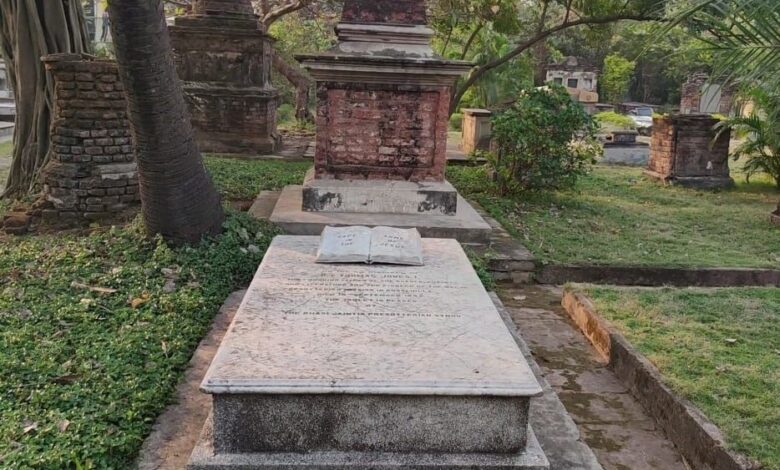Revisiting Thomas Jones’s history in heritage Kolkata cemetery
On Thomas Jones Day, Dr Neeta Das, cemetery restoration project architect, talks about the Welsh missionary & works of KSHT


The cacophony of Karaya Road in Kolkata’s Mullick Bazar suddenly falls silent as one crosses the gate into the two-century-old Scottish Church Cemetery. The chai-shop gossip, the clinking and pounding of garage tools, the honking ambassador taxis and the incoherent rantings of office-goers and labourers are shut out of the dead’s world. Somewhere in the necropolis is buried Rev. Thomas Jones, the father of the Khasi language.
“There are 1,809 graves in the cemetery with over 4,000 people interred and the most famous personality, based on the number of visitors it gets annually, is Rev. Thomas Jones,” Dr Neeta Das, architectural historian and conservation architect, told Meghalaya Monitor in an email interview.
The Welsh missionary died of malaria in erstwhile Calcutta in 1849. He was only 38 years old. The epitaph at his grave, demarcated as grave plot number 628, says, “Safe in the arms of Jesus/In loving memory of Rev. Thomas Jones 1./The founding father of the Khasi alphabets/and literature and the pioneer of the Welsh Presbyterian mission in Khasi Hills./Died 16th September 1849.” In fact, the tablet at his grave was placed after renovation by the Khasi Jaintia Presbyterian Synod.
When Meghalaya Monitor visited the cemetery end of last year, renovation and restoration works were underway. Later Das, who is the lead project architect, said restoration started in 2008 and “we hope to complete the first phase, that is the overall development of the site and regeneration of the neighbourhood, by 2024”.
“Phase two, which would deal with sustainable management, is still under consideration and negotiations of the funders, the Kolkata Scottish Heritage Trust (KSHT, a private charity in Scotland), with the (site) owner, St. Andrew’s Church, is ongoing,” she added.

The burial ground, which is spread over 3 acres of land, was laid out in 1820. A walk around the heritage site and one can discover from the writings on the epitaphs and sepulchres that several prominent personalities are buried here. One can find the graves of Lal Behari Day, who was an eminent Bengali Christian missionary and educationist; Rev. John McDonald, who was a missionary of the Free Church Mission and one of the editors of Calcutta Christian Mission; Samuel Charters Macpherson, who was a political agent in Gwalior during the revolt of 1857 and played a key role in convincing the Khond tribe of Odisha to give up human sacrifice; and Doorga Moni Das Basu, the wife of Dr Dwarkanath Das Bose who was a member of the Royal College of Surgeons, London.
“It is interesting to note that the people buried in the Scottish Cemetery collectively tell more interesting stories than the few ‘personalities’ who are buried here,” said Das.
The list of the names can be found on the website of Scottish Cemetery Kolkata.
The cemetery — which is a meter away from another heritage site, the South Park Street Cemetery, is hard to spot on the congested street. Das said there are several challenges in preserving the heritage site.
“Maintaining law and order in cemeteries, especially at night is a big challenge for any cemetery. They become a hot spot for drug addicts etc. and are difficult to evacuate. The second problem is getting funding to maintain these cemeteries in the long run, especially historic cemeteries like this which are not active anymore… One has to be vigilant and constantly engaged in maintaining the cemetery and keeping it relevant,” she added.

Besides the restoration of the heritage site, two more programmes are run under the banner KSHT — the first is value education for children and the second is skill training for adults. Simultaneously, KSHT is also working towards urban regeneration around the cemetery to maintain the sanctity of the precincts and encourage researchers and scholars to use the space for academic purposes.
When Meghalaya Monitor approached Das for an interview and informed her that June 22 is celebrated as Thomas Jones Day in Meghalaya, the project architect was intrigued by the information. “I had not realised Rev. Jones was so important and had a holiday named after him!”
June 22 is commemorated as the day when Rev. Jones arrived in Sohra in the early 1840s.
Though at present there is no educational exchange programme for students from Meghalaya and West Bengal, Das said it would be interesting to engage with such a programme.
When asked whether Das and her team members would be interested in teaching the underprivileged children in the Kolkata neighbourhood about Meghalaya and other parts of the North East, which is still a lesser-known part of the country, Das said, “I will definitely ask my teacher to incorporate this, maybe on this Thomas Jones Day itself!”
~ Team Meghalaya Monitor





